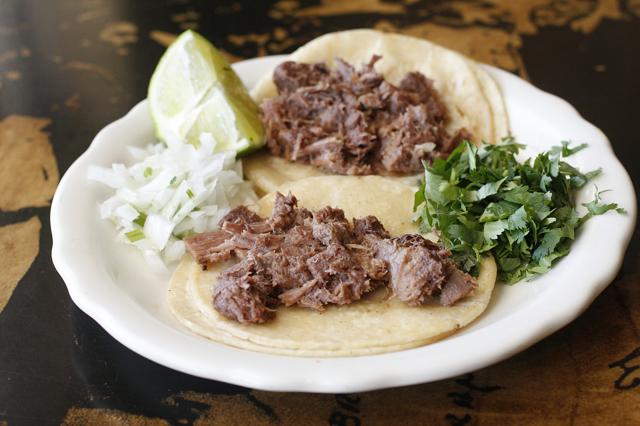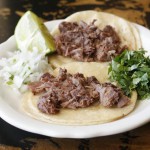- Tongue, no cheek: Lengua tacos, like these from Taqueria Fast, are common Mexican fare. Photos by Jonathan Welch
- Dynamic duo: Table co-chefs Matthew Dawes (left) and Jacob Sessoms like to think outside of the filet to keep things fresh.
- Heart attack: Cucina 24 serves beef heart from time to time. Here, chef Brian Canipelli has plated it with with farm egg and Brussels sprout salad.
Living well used to mean eating high on the hog — literally. Popular culture has it that the phrase came from consuming the more acceptable (and expensive) pieces of a pig, namely the ham and chops. These days, many foodies are eschewing those cuts for less elegant parts. Nose-to-tail is the new farm-to-table and pork belly is the new gateway drug, often leading straight down the road to head cheese and heart.
And while many in our culture still balk at offal, considering organs like the pancreas to be castoffs, others are reaching for the tongue and clamoring for kidneys.
It takes heart
Brian Canipelli, owner and chef of the modern-Italian Cucina 24 on Wall Street in downtown Asheville, blames (or credits) the new foodie daredevil tendencies on celebrity chefs, like Anthony Bourdain, who make a living out of shock-value eating. Canipelli thinks that Food Network shows like Bourdain's No Reservations are, in part, responsible for an increase in appetite for foods that were not considered viable menu items until recently.
"It's kind of become glorified," says Canipelli. And food trends, he says, catch on quickly — and become passé even quicker.
"I think it's a natural progression of the farm-to-table thing. Three years ago, it was organic produce. Maybe this is just the next big trendy thing."
But for Canipelli, it's not necessarily about keeping up with the Joneses (or the Fergus Hendersons, for that matter). The organ meats that can stand out on a menu for the most daring of customers can also be cost-effective for the chef — even if they may require extra elbow grease.
"A lot of it is better for me from an economical standpoint, especially with how expensive food is to buy now," Canipelli says. "You can buy economical cuts and treat them the right way and they become a great thing to eat."
Furthermore, he says, part of the allure of "strange" food is that, in an age of increasingly deft (but still amateur) home cooks, many still have no idea what to do with a thymus gland. "Part of the reason that people go out to eat in the first place is because they want to pay for something that they can't make at the house," he says. "People don't tend to go out and buy these cuts of meat at the grocery store."
But how receptive are Asheville diners to this stuff anyway? Even though we tend to consider ourselves quite the sophisticated connoisseurs for such a small town, are people really ready for heart?
Absolutely, says Canipelli, who snatched up local beef heart from Hickory Nut Gap Farm on a whim for a cheeky Valentine's Day special. And at $2 a pound, he says, why not?
"That was the first thing that we sold out of Valentine's Day," says Canipelli. "Maybe because it was heart on Valentine's Day, but the next day we sold a bunch, too."
Tongues are wagging
In many areas of the world, especially those with culinary traditions influenced by peasant food, eating organ meat is nothing extraordinary — it’s a fact of life.
"I didn't grow up eating that kind of stuff," says Canipelli. "The French did. The Italians did. But their food traditions are a lot older than ours. They're more about using every single thing, where our food culture has been raised on boxed foods — and we'll only eat the filet."
And indeed, organ meat is not traditionally the province of avant garde cooking. It's been a substantial part of the regular diet of cultures around the world for ages. But the U.S. is catching up and becoming more open-minded all the time.
Roberto Camacho, the owner of Taqueria Fast, a tiny and authentic taqueria in north Asheville, hails from Calisco, Mexico. Where he's from, he says, many different parts of the animal are eaten without so much as a shrug. Dishes like ox tails, lengua (tongue) or the tripe-filled menudo are common (tripe is the stomach lining of a cow, should you want to know). "Everyone just enjoys the food and no one ever complains," he says.
Maria Manso, who works at Taqueria Fast, adds that the restaurant's lengua tacos are popular with Americans and Latinos alike. "Some of them feel a weird sensation because they’re eating tongue, but after they get over that, they really like it," she says. "And a lot of them really enjoy it."
Heads and tails
Jacob Sessoms and Matthew Dawes, co-chefs at Table, the modern-American restaurant on College Street, cook with underutilized cuts and organs frequently. Do they consider that strange? No. But is it more interesting than cooking filet mignon? Absolutely.
"From a chef's perspective, as you explore culinary traditions beyond the last 50 years in America, nobody else leaves [offal] out," says Sessoms. "And the concept of calling it 'strange' is some constraint that our contemporary culture has put on it. Certainly nobody else's culture views it as such."
And as chefs build closer relationships with their local farmers, adds Dawes, they become more aware of what's available to them. "They become more attuned to the fact that there's different parts of the animal that are getting thrown out, basically, or made into dog food," says Dawes. "Also, when you cook 40 to 80 hours a week, you get tired of chicken breast and filet mignon. I think that offal is something that you will exploit just for the sake of finding new things to cook."
Not everything that comes to a chef’s mind is available, even straight from the farmer. Many who raise meat locally have to take their animals to an offsite production facility. "The processors won't always do it,” Dawes says. “I couldn't make my haggis this year, for example." (Haggis is a traditional Scottish dish of stuffed sheep’s stomach — recipes for this dish often make for a fun read.)
Table, like Cucina 24, features heart on the menu from time to time, though the chefs primarily cook lamb, duck and rabbit hearts, says Dawes. Often, the rabbits and ducks that they purchase whole come with those organs intact. It's a good way to utilize the whole package, creating very little waste. And diners, for the most part, are quite receptive to the idea.
"Small animal hearts and livers we've had success with in the past," says Sessoms. "It's the bigger animals that seem to be difficult to sell. Though, Matt did put lamb testicles on the menu this summer, much to my chagrin," he says. "But it worked. It sold."
The biggest challenge right now, says Dawes, is securing the more unusual cuts and organs. While sources for foie gras are plentiful enough, other parts are not. Heart can be hard to come by, says Dawes. And sometimes, even if the chefs manage to get their hands on the items they want, it might not quite be worth the trouble.
The nose-to-tail philosophy of cooking, obviously, can come with a price. Table uses pig ears to make a version of coppa di testa, which translates to "cup of head," the chefs tell Xpress. "And to get pig tails or pig ears, well, they come with the hair on sometimes, which is a nightmare," says Dawes.
"One time, we got an entire 50 pounds of pig ears from Jamie (Ager) at Hickory Nut, and they all had hair on them," says Sessoms. "I said ‘throw them away,’ because it wasn't worth it. But Matt tried to shave them — with a Bic razor. Then he tried to torch them."
"I smelled like singed pig hair for two days," says Dawes.
— Send your food news to Mackensy Lunsford at food@mountainx.com.






Great article, Mackensy!
I’d like to point out that we also offer a unique product, our rabbit pate’. It was *very* popular this past holiday season and we look forward to providing it this year at the North Asheville Tailgate Market (opening April 16th!) as well as other local tailgates.
Walt
http://www.imladrisfarm.com
Rabbit Pate’?
You ate Thumper! Waaaahh!!!!